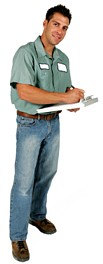Introduction to Termites
Termites, like bees and ants, are flying insects that live in colonies and have workers and soldiers. Termites become a problem not just as a nuisance insect in the house, but because they can eat wood and damage the house structure. In addition to wood, termites also eat paper, bark mulch, and dead tree roots. They can also damage cotton, burlap, and other plant fibers.
Termite colonies are usually underground nests. This fact, coupled with their ability to enter a dwelling through a very small masonry gap and that their wood dining leaves no sawdust means that they can go undetected for a very long time. Workers are less than ¼” (6.35 millimeters) long, but colonies can grow to have millions of workers. Because they may eat wood from the inside out, there may be no signs of damage to visible wood for a long time.
There are three tell-tale signs of termite presence. Because the wings drop off of reproducing termites right after mating, dropped wings may pile up. Another sign is the fecal pellets left in the galleries in the wood close to a water source. An even larger sign is the swarm of reproducing termites that can appear within infested buildings in the spring.
PreventionBecause the initial signs are very small, preventing termite infestation takes diligent checking. Here are some ideas:
- Install wooden stakes around the outside perimeter of the home, and use them to monitor whether termites might be active in less visible spots.
- Check all areas of damaged or broken masonry for insects.
- Check all house features that are both wood and close to the ground, such as doors, door frames, basement window frames or sills, siding, stairs, and posts.
- Check the foundation for cracks that might allow entrance.
Treatment
Treatment of termites is best done by professionals and involves at least two separate tasks. One task is to destroy the termite colony. The other is to assess the damage and take any necessary measures to insure the integrity of the building.
If there is furniture that is infested, you can take the step of discarding it. If you wish to treat it, there are two methods that homeowners can safely undertake: heat and cold. Raising the furniture’s temperature to 120ºF (48.88ºC) for several hours will kill the termites, as will freezing it for several days. If insecticide or fumigation is required, this again is a task best left to a professional.
Treatment of termites changed in the 1980s when organochlorine insecticides that had been used—like chlordane and heptachlor—were banned in the United States. It is common today to find the use of baits.
 Today, professional pest controllers can apply pre-construction pesticides to create a barrier of toxin around the building that prevents termites from moving into the structure. Similar soil treatments can be applied post-construction. Although there has been little known damage from these practices, there is a potential risk. The effects of these applications last from five to ten years.
Today, professional pest controllers can apply pre-construction pesticides to create a barrier of toxin around the building that prevents termites from moving into the structure. Similar soil treatments can be applied post-construction. Although there has been little known damage from these practices, there is a potential risk. The effects of these applications last from five to ten years.
With newer third option, termite bait, exterminators leave poison bait in specific areas. This method counts on worker termites to bring it back to their nest where it will destroy the entire colony. This is a less toxic alternative than the barrier method. Although baits are now available to homeowners, some experts strongly recommend not taking a do-it-yourself approach to termite treatment, both because the value of what’s at stake (your home) and because bait in itself may not be a complete solution.
Written by Mary Elizabeth
Related Home Institute Articles
